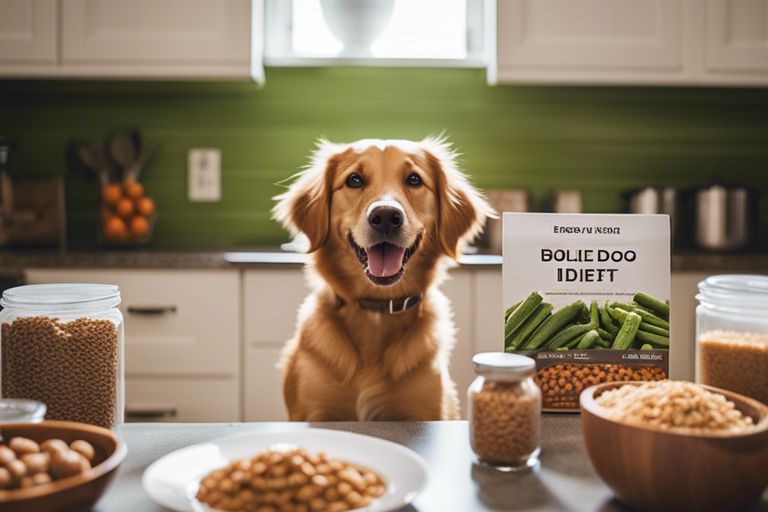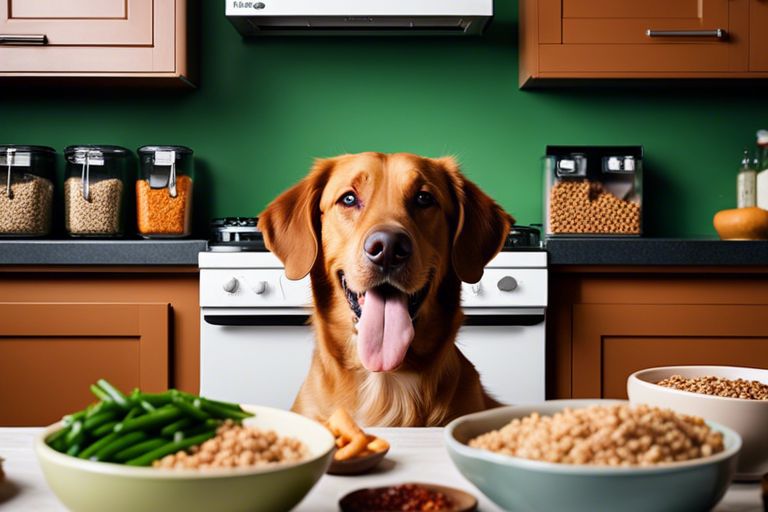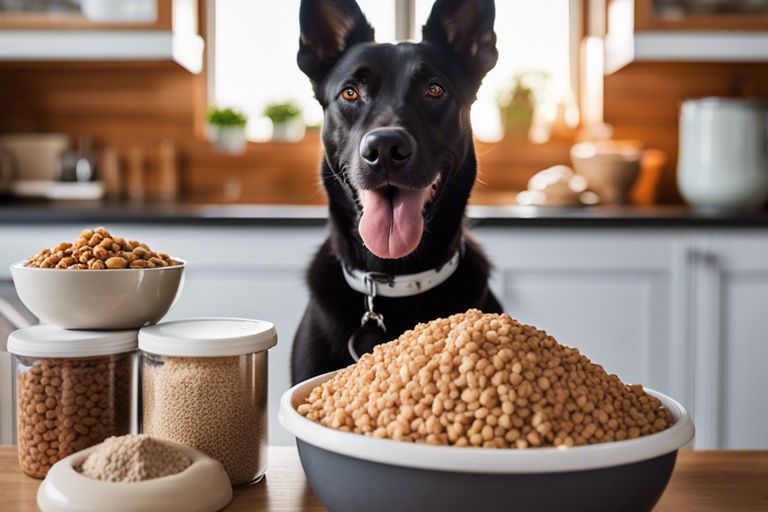Just like humans, our furry friends deserve a wholesome diet that nourishes their bodies and keeps them healthy. So, if you find yourself wondering what to feed your dog instead of the standard dog food, you’ve come to the right place. In this blog post, we will explore some nutritious and delicious alternatives that you can incorporate into your pet’s diet to make sure they are getting the best possible nutrition.
Key Takeaways:
- Consider a raw diet: Some experts recommend feeding dogs a raw diet consisting of raw meat, bones, and organs, as this mimics what they would eat in the wild and can be beneficial for their health.
- Homemade dog food: Making homemade dog food using ingredients like lean meats, vegetables, and grains can provide a well-balanced diet for your furry friend, tailored to their specific needs.
- Consult a veterinarian: Before making any significant changes to your dog’s diet, it’s vital to consult with a veterinarian to ensure that the new diet will meet all of your dog’s nutritional requirements and won’t cause any health issues.
In exploring alternatives to conventional dog food, it’s crucial to keep an open mind and consider options that could potentially benefit your dog’s overall well-being. By embracing a raw diet, homemade dog food, or consulting with a trusted veterinarian, you can provide your canine companion with a diet that caters to their specific nutritional needs and supports their health in the long run.
The Problem with Commercial Dog Food
To explore the issues with commercial dog food, it’s imperative to understand the potential drawbacks that can come with feeding your pet only this type of food. While convenient, commercial dog food may not always provide the best nutrition for your furry friend. In times when you run out of dog food, you may wonder what you can feed your dog instead that will be healthy and balanced.
Preservatives and Additives
To highlight the concern about commercial dog food, one major issue to consider is the presence of preservatives and additives. These chemicals are often used to extend the shelf life of the dog food but may not necessarily be beneficial for your pet’s health. Some dogs can have sensitivities or allergies to these ingredients, leading to digestive issues or other health problems.
Lack of Nutritional Value
Additives in commercial dog food can sometimes reduce the overall nutritional value of the product. While the packaging may claim to provide a balanced diet for your dog, the reality can be quite different. Some ingredients may be included more for cost-effectiveness or to enhance taste rather than to meet your dog’s specific dietary needs.
Plus, certain nutrients may be lacking in commercial dog food, especially if your dog has specific health requirements or allergies. In these cases, finding alternative sources of nutrition becomes crucial to ensure your pet’s well-being and longevity.
The Benefits of Feeding Your Dog Alternative Foods
Improved Digestion
To ensure that your canine companion has optimal digestion, it is necessary to provide them with a diet rich in whole foods that are easily digestible. By incorporating fresh ingredients such as lean meats, vegetables, and fruits, you can help support your dog’s digestive system and overall gut health. These natural foods are packed with nutrients and enzymes that aid in the digestion process, leading to better nutrient absorption and firmer stools.
Increased Energy
An active and energetic dog is a happy dog. By feeding your furry friend alternative foods like high-quality proteins and complex carbohydrates, you can help sustain their energy levels throughout the day. These nutrient-dense foods provide a steady source of fuel for your dog’s muscles, promoting endurance and vitality. Say goodbye to midday slumps and hello to a more lively and playful pup!
Plus, by avoiding artificial additives and fillers commonly found in commercial dog foods, you can prevent spikes and crashes in energy levels, keeping your dog consistently energized and ready for all the adventures you share together.
Shinier Coat
Feeding your dog a diet rich in necessary fatty acids, vitamins, and minerals can do wonders for their coat health. These nutrients help nourish your dog’s skin from within, reducing dryness and itchiness while promoting a soft and lustrous coat. Omega-3 fatty acids, in particular, are known for their anti-inflammatory properties, which can help alleviate skin issues and contribute to a glossy coat.
Shinier coats not only look beautiful but also indicate a healthy dog from the inside out. So, by choosing wholesome ingredients like salmon, flaxseeds, and sweet potatoes, you can help your furry friend achieve that enviable shine that will turn heads at the dog park.
Human Foods Safe for Dogs
Despite the convenience of commercial dog food, many dog owners are turning to more natural alternatives for their furry companions. It’s important to know which human foods are safe for dogs and can provide the necessary nutrients for their well-being.
Lean Proteins: Chicken, Fish, and Beef
Chicken is a fantastic lean protein source for dogs. Make sure it is cooked thoroughly and without any seasoning or bones that could be harmful. Fish, like salmon or sardines, are excellent for providing omega-3 fatty acids that promote a healthy coat and skin. Lean beef can also be a good option, but make sure it’s cooked well and free of any fatty pieces.
Vegetables: Carrots, Green Beans, and Sweet Potatoes
Potatoes are not only safe for dogs but also packed with crucial vitamins and minerals. Sweet potatoes are a great source of dietary fiber, which can aid in digestion. Green beans and carrots are low in calories and a good source of nutrients like vitamin C and K. They can be given to dogs either cooked or raw as a crunchy snack.
A varied diet including these vegetables can be beneficial for your dog’s overall health and well-being. Just ensure that any vegetables given to your dog are appropriately prepared and free from any seasonings or oils that may be harmful to them.
Fruits: Apples, Bananas, and Blueberries
For a sweet treat, dogs can enjoy fruits like apples, bananas, and blueberries. Apples are rich in vitamins A and C, while bananas provide potassium and fiber. Blueberries are packed with antioxidants that can help boost your dog’s immune system and overall health.
Safe for consumption, these fruits can be given as occasional treats or added to your dog’s meals to provide a nutritious boost. Remember to remove any seeds or pits that may be harmful to your furry friend.
Foods to Avoid Feeding Your Dog
Toxic Substances: Chocolate, Grapes, and Onions
Unlike humans, dogs can suffer severe health consequences from ingesting certain foods that are harmless to us. These include toxic substances like chocolate, grapes, and onions. Feeding your dog chocolate can lead to symptoms ranging from vomiting and diarrhea to more serious issues like seizures and even death. Grapes and raisins are also known to cause kidney failure in dogs, while onions can lead to harmful effects on their red blood cells.
High-Fat Foods: Bacon, Sausages, and Fried Foods
Toxic high-fat foods like bacon, sausages, and fried foods should be kept away from your furry friend’s reach. These items can cause pancreatitis in dogs, a painful and potentially fatal inflammation of the pancreas. Symptoms of pancreatitis include vomiting, diarrhea, loss of appetite, and abdominal pain.
It’s imperative to keep these fatty foods out of your dog’s diet to ensure their long-term health and well-being. While it may be tempting to share your breakfast bacon with your pup, it’s best to stick to dog-friendly treats that won’t put their health at risk.
Dairy Products: Milk, Cheese, and Eggs
Foods like milk, cheese, and eggs, while tasty for us, may not sit well with your dog’s digestive system. Dairy products can cause gastrointestinal upset in dogs, leading to symptoms such as diarrhea and bloating. While small amounts of cheese as an occasional treat may not harm your dog, it’s best to avoid feeding them these products regularly.
Remember that dogs have different nutritional needs than humans, and what may be a delicious snack for us could cause discomfort for your furry companion. Always prioritize your dog’s health by sticking to a balanced and dog-friendly diet.
Creating a Balanced Diet for Your Dog
Now, let’s discuss how to create a balanced diet for your furry friend. This is imperative to ensure your dog is receiving all the necessary nutrients for good health and vitality. A balanced diet includes a mix of proteins, carbohydrates, fats, vitamins, and minerals in the right proportions.
Calculating Caloric Needs
Calculating your dog’s caloric needs is the first step in creating a balanced diet. Factors such as age, weight, activity level, and breed play a role in determining how many calories your dog requires each day. Consulting with your veterinarian can help you determine the appropriate caloric intake for your dog.
Mixing and Matching Foods
Any diet for your dog should include a variety of foods to ensure they receive a wide range of nutrients. Mixing different sources of proteins, carbohydrates, and vegetables can help provide a balanced diet. You can incorporate lean meats, whole grains, and vegetables into your dog’s meals to add variety and nutrition.
Matching your dog’s food to their specific dietary needs is crucial. Some dogs may have allergies or sensitivities to certain ingredients, so it’s important to tailor their diet accordingly. Be mindful of your dog’s preferences and any health issues when selecting and combining different foods for their meals.
Avoiding Nutrient Deficiencies
Nutrient deficiencies can be harmful to your dog’s health, leading to various health issues. To avoid deficiencies, make sure your dog’s diet is well-balanced and includes all the imperative nutrients they need. Monitoring their diet and making adjustments as needed can help prevent potential deficiencies.
Foods rich in imperative nutrients like protein, omega-3 fatty acids, vitamins, and minerals are key components of a balanced diet for your dog. Including a variety of nutrient-dense foods in their meals can help support their overall health and well-being.
Tips for Transitioning Your Dog to Alternative Foods
Once again, transitioning your dog to alternative foods should be done gradually to avoid any digestive upset or resistance from your furry friend. Here are some tips to help make the transition smoother:
Gradual Introduction of New Foods
Foods that are significantly different from your dog’s current diet should be introduced slowly. Start by mixing a small amount of the new food with your dog’s regular food, gradually increasing the proportion over a period of 7-10 days. This gradual transition will give your dog’s digestive system time to adjust to the new ingredients.
Monitor your dog’s reaction to the new food during this transition period. Look out for any signs of digestive issues such as diarrhea, vomiting, or lack of appetite. If you notice any of these symptoms, slow down the transition process and consult with your veterinarian.
Monitoring Digestive Health
On top of observing your dog’s behavior, keep an eye on their stool consistency and frequency during the transition period. Any sudden changes in these factors could indicate that the new food is not agreeing with your dog’s digestive system.
For instance, if you notice loose stools or constipation persisting for more than a couple of days, it may be a sign that the new food is not suitable for your dog. In such cases, consider switching back to their previous diet and consulting with your veterinarian for guidance.
Consulting with a Veterinarian
The key to a successful transition to alternative foods lies in seeking guidance from your veterinarian. They can provide valuable insights into your dog’s nutritional needs and help you create a customized feeding plan that suits your dog’s individual requirements.
Monitoring your dog’s overall health and well-being is crucial during this transition period. Your veterinarian can also conduct any necessary tests to ensure that your dog is tolerating the new diet well and address any concerns that may arise.
Summing up
Considering all points, it’s clear that there are various alternatives to traditional dog food that can provide your furry companion with a nutritious and balanced diet. From fresh fruits and vegetables to lean meats and grains, there are plenty of options to explore. By incorporating these wholesome ingredients into your dog’s meals, you can ensure they are getting the crucial nutrients they need to thrive.
For more information on the benefits of fresh and raw dog food compared to traditional kibble, check out Fresh vs Raw Dog Food vs Kibble: Which Diet Is Best For …. Your furry friend will thank you for providing them with a diet that meets their unique nutritional needs and tastes delicious too!
FAQ
Q: Why should I consider feeding my dog something other than dog food?
A: Feeding your dog a variety of fresh, whole foods can provide a wide range of nutrients that may be lacking in processed dog food. This approach can also help promote better overall health and well-being for your furry companion.
Q: What are some alternatives to traditional dog food?
A: Some alternatives to traditional dog food include cooked meats (such as chicken, beef, or turkey), fruits and vegetables (like carrots, apples, and sweet potatoes), and grains (such as rice or oats). These whole foods can be combined to create balanced meals for your dog.
Q: How can I ensure my dog is getting all the necessary nutrients from homemade meals?
A: To ensure your dog is receiving important nutrients, it’s important to offer a variety of foods in their diet. This can include a mix of proteins, carbohydrates, healthy fats, vitamins, and minerals. Consulting with a veterinarian or canine nutritionist can help create a well-rounded meal plan.
Q: Are there any foods that are harmful to dogs and should be avoided?
A: Yes, there are several foods that are toxic to dogs and should be avoided, including chocolate, grapes, raisins, onions, garlic, and foods containing xylitol. It’s crucial to research and double-check the safety of any new foods before feeding them to your dog.
Q: How should I transition my dog to a new diet of homemade meals?
A: When transitioning your dog to a new diet, it’s important to do so gradually to avoid digestive upset. Start by mixing a small portion of the new food with their current food and slowly increase the ratio over a week or two until they are fully transitioned to the new diet.




